Where to Dine and Taste Local Wine in the Tuscan Region of Bolgheri
Le Macchiole’s Cinzia Merli reveals the secrets of this sea-bounded Tuscan wine region.
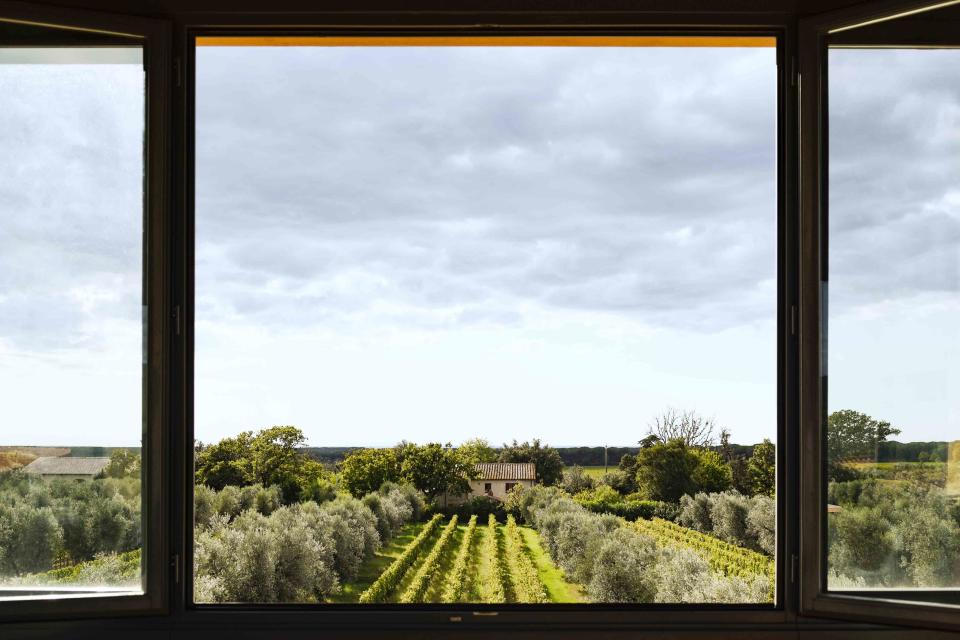
CHARISSA FAY
A view across the vineyards to the Tyrrhenian Sea at Chiappini in Bolgheri, Italy“This area, Bolgheri, is very special for potatoes,” Cinzia Merli is saying as she rolls out a rope of gnocchi dough on a cutting board dusted with flour. “If I ever had to change my life completely, I could grow potatoes. And what’s the secret to gnocchi? Good potatoes.”
Merli is the proprietor of one of Bolgheri’s benchmark wineries, Le Macchiole. She makes world-class reds (and one white) from the Tuscan estate’s 86 acres of vines, wines that live in the same rarefied atmosphere as the great Super-Tuscans that brought the region its fame (Sassicaia and Ornellaia, particularly). But she also makes excellent gnocchi. “January through April? You can’t make good gnocchi,” she says, slicing the dough into small, even pillows. “The potatoes lose too much water. The new crop comes again in May.”
In her kitchen at the winery, the light slants through the windows and the open door — it’s a temperate day, with a soft breeze off the coast rustling through the vine leaves outside. Though Merli will claim over and over that she’s not a great cook, this is just her nature. She’s modest about everything except her wines. (Those she is justifiably proud of.) She says, “My mother is a much better cook than I am. And my younger son even says that! ‘I made some ragù, do you want some?’ ‘Yes.’ ‘OK, how was it?’ ‘It was good, but Nonna does it better.’” What can you do? her expression says.
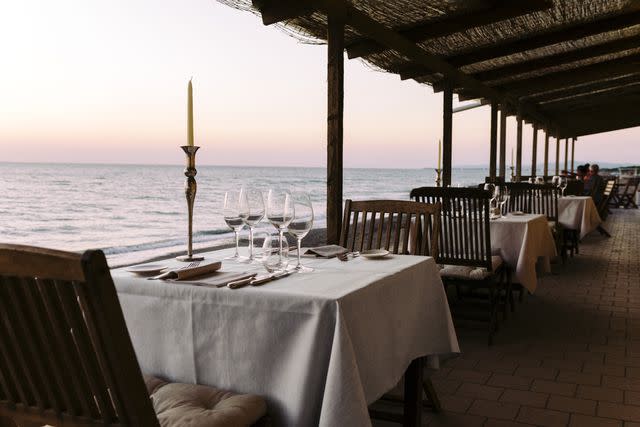
CHARISSA FAY
At La Pineta, ultra-fresh seafood comes with a stellar view.Both of Merli’s sons are now in their early 30s and work for the family company. Elia, the older, oversees the vineyards; his younger brother, Mattia, helps with sales and marketing. Le Macchiole has been their life. Elia says, “Officially, I started in 2013, but the first time I worked in the vineyard, I was probably 6 years old. I had my small scissors, I harvested two vines, and I said, ‘OK, now I am tired.’ But every Saturday, I went in the truck with my father to go sell the wines.”
Merli and her husband, Eugenio Campolmi, founded Le Macchiole together in 1983, against his own parents’ wishes. “Agriculture was not good at the time, and wine was worse,” Merli says. “But he bought this property anyway and took out a 500 million lire mortgage [about $300,000 at the time]. It was a big problem.” Both of them had grown up in the area; Campolmi’s family owned a small restaurant, and Merli’s family were farmers. Campolmi’s instincts about Le Macchiole’s potential proved correct. “In 1995, that was when everything changed,” she says. “There was a France-versus-Italy tasting of the 1992 vintage at Vinitaly [the massive wine trade show that occurs yearly in Verona]. Sassicaia, Ornellaia, Redigaffi, us, against Château Pichon Lalande and the other great Bordeaux properties. And Le Macchiole was second overall. Nobody knew us, and suddenly, everything changed. Overnight. Everyone was coming to our booth, wanting to taste.”
The late 1990s were halcyon years for the couple. Then, Campolmi was diagnosed with lung cancer, and in July 2002, he died. He was 40. Merli was 35; Elia and Mattia were 13 and 9. Even then, women rarely, if ever, ran wineries in Italy. Everyone in the region, in the standard chauvinistic way of the times, assumed she would sell — everyone except Merli herself. She kept on.
Related: The Best Wineries to Visit in Tuscany
“I lost my husband in July, and the harvest that year was the worst in 15 or 20 years: cold and incredibly rainy. Then 2003 was really hot — so hot. And I started to think, This is a sign. I’m being told not to do this. This is not my work, not my destiny. But my brother came to me and said, ‘Listen: one more vintage. Then you decide.’ So, 2004. I think the moment for me was when we released the 2004 vintage, and our wine Messorio got 100 points. And probably a lot of people thought, OK, she actually can do this.” She smiles. “Well, yes.”
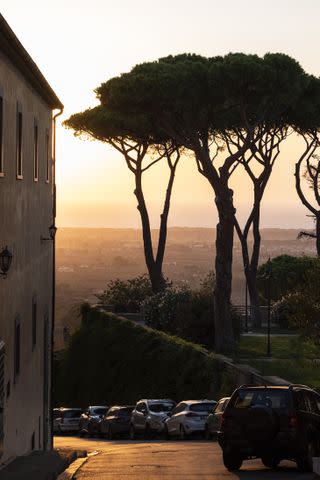
CHARISSA FAY
The view at Relais dei Molini in Castagneto Carducci.Today, Le Macchiole is internationally recognized as one of Tuscany’s greatest estates. It has changed in some ways: The original 10 acres of vineyards have grown to 86 over the years. All are farmed organically. “We went organic because Eugenio got sick,” Merli says. “I didn’t want to expose anyone else at the winery to those risks.” But it is still very much a family business, and a farm, more than anything else. “My family are farmers, and I like to think of Le Macchiole that way,” Merli says. “Not just as a wine producer.”
Bolgheri has changed, too. It never fit the classic idea of Tuscany — the hilltop towns; the yellow and orange villas; all that Under the Tuscan Sun, languorous, find-your-bliss-through-pasta cliché. Bolgheri is on the coast, a subregion of the larger Maremma (specifically, it’s in the Maremma Livornese, or Alta Maremma), the lowlands of which were, until the mid-1800s, more or less a malarial swamp. As one old Tuscan folk song has it, “Everybody tells me about Maremma, Maremma / But it seems to me that Maremma is bitter / The bird that goes there loses its feathers / I lost a loved one there / May Maremma, Maremma be damned.” Cheery! But in the 1820s, the Grand Duke of Tuscany, Leopoldo II, brought in some 5,000 workers to turn the swamp into fertile land, and that fertile land proved — at least by the 1980s — to be perfect for wine grapes. Not the traditional Sangiovese of Tuscany, but French varieties, which are what, in 1983, Campolmi and Merli planted: Syrah, Cabernet Franc, Cabernet Sauvignon, and Merlot, among others.
In essence, Bolgheri is where the hills of Tuscany meet the sea, and as a place to visit, it offers the best of both. Fresh fish abounds in its restaurants, but so does the famed Chianina beef of Tuscany’s inland regions. You can buy wild-boar prosciutto at a salumeria in a tiny town perched above the coast (Specialità Mucci e Staccioli, in Monteverdi Marittimo) then descend down winding roads and find yourself sipping a spritz at sunset in an outdoor bar with a view of the water (Colto e Mangiato, just down the street from Le Macchiole). Spend time with Merli, and inevitably you’ll end up at some of her favorite spots: the Piccolo Biscottificio Castagnetano in Castagneto Carducci, where the Biagioni family makes traditional corolli incesi, biscotti with an eagle-shaped outline that references the coat of arms of the noble Gherardesca family; Osteria Magona, where chef Omar Barsacchi will cook you a massive bistecca alla Fiorentina to go with Le Macchiole’s complex, compelling Paleo Rosso red; or La Pineta, where you can sit at a table looking over the Tyrrhenian Sea at sunset and know that the fish on your plate came from that water a few hundred feet away. Or you can just spend a day sunning yourself on the beach, not an uncommon pursuit, especially for the residents of Livorno to the north. “The Livornese are tan from March to November,” Merli says. “They’re like lizards on the rocks as soon as the sun comes out.”
Related: How to Drink and Eat Your Way Through Tuscany In Just Three Days
But if you are lucky, you’ll just sit down to eat whatever Merli herself decides to cook. On a recent day, that meant those gnocchi, tossed with asparagus and pancetta, risotto with zucchini and shrimp, and an herb-crusted roast pork loin. We talked about Bolgheri, what it was and what it’s become. It’s more visited than it once was, no question, but it still lacks the hordes who descend on Siena or San Gimignano (or, even more alarmingly, Florence). There’s also been a boom in wineries, the number rising from 45 to 70 just since 2019. “Tourism really started picking up 10 years ago,” Merli says. “I’m convinced it’s the richness of our region. Not just the wine — the wine is the money, sure. But we have so many things to offer. And we help each other. In Bolgheri, success is a currency shared by everyone.”
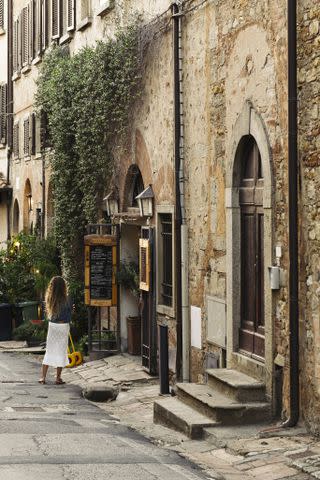
CHARISSA FAY
The atmospheric streets of the tiny town of Bolgheri.Bolgheri wines to try
2021 Le Macchiole Bolgheri Rosso ($40)
There’s no better introduction to the wines of the region than this elegantly powerful red, a blend of Merlot, Cabernet Franc, Cabernet Sauvignon, and Syrah. But to truly experience the brilliance of Cinzia Merli’s wines, seek out her 2021 Paleo Rosso ($125). It’s aromatic, long-aging, and inarguably one of the world’s greatest Cabernet Francs.
2021 Chiappini Felciaino ($45)
The Chiappini family moved to Bolgheri in the 1950s and has been making wine here since the 1980s (and now farms 100% organically). This Cabernet-based blend is vivid, with lots of red cherry–berry flavor and fine-grained tannins.
2020 Grattamacco Bolgheri Vermentino ($50)
Grattamacco was one of the earliest estates in Bolgheri and helped build the region’s reputation. Its white — floral, peach-inflected, full-bodied but crisp — is a standout with any kind of seafood.
2020 Poggio al Tesoro Sondraia ($95)
This is the flagship red of Marilisa Allegrini’s stunning property in Bolgheri. (The Allegrini family also owns wineries in Brunello and in Valpolicella.) Primarily Cabernet Sauvignon with small amounts of Merlot and Cabernet Franc, it’s structured and complex, meant for aging.
2020 Ornellaia ($310)
One of the stars of the region, Ornellaia’s 2020 vintage is a gorgeously layered, structured blend of 50% Cabernet Sauvignon with Merlot, Cabernet Franc, and Petit Verdot. At a more modest price, look for the 2020 Le Serre Nuove dell’Ornellaia ($70), which leads with Merlot. It’s still very impressive — a good option for drinking now.
A local's guide to Bolgheri
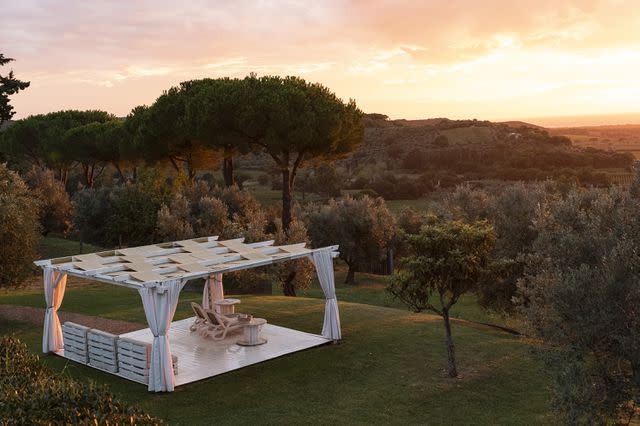
CHARISSA FAY
Where to dine and sleep in Bolgheri
Osteria Magona
Chef Omar Barsacchi’s bistecca alla Fiorentina is second to none, and his wine list at this converted farmhouse features lengthy verticals of Bolgheri’s greatest reds. Barsacchi himself, 6 feet, 5 inches tall and bearded, looks like he stepped right out of Game of Thrones. When I met him, he was headed out the door, on his way to Sweden to hunt woodcocks with his father. osteriamagona.com
Colto e Mangiato
Appealing seasonal, open-air bars are a growing trend in Bolgheri. This one is a primo place to order some local wine and a plate of excellent housemade charcuterie, then settle in at a picnic table on the bar’s expansive lawn. coltoemangiato.com
Il Bucaniere
At this seaside restaurant in San Vincenzo, chef and fisherman Fulvietto Pierangelini does wonders with fresh seafood, like a tartare of raw shrimp, ricotta, and artichokes, and with pastas as well. “He doesn’t speak much, but he’s amazingly talented,” Cinzia Merli says. ristoranteilbucaniere.com
Lo Scoglietto
This whitewashed seaside spot in Rosignano Marittimo is a favorite of local winemakers, not least because of its extensive Champagne selection. Sit outside, order the delicate and ultra-fresh frittura mista, pop a bottle of bubbles, and people-watch the bathers on the beach. loscogliettorosignano.it
La Pineta
“I was born two kilometers from here,” Merli says about this elegant yet unpretentious eatery on the beach in Marina di Bibbona. “I played on this beach when I was a child. It’s my home.” Expect local fish, caught fresh daily; sublime pastas like spaghetti with mussels, mint, and lemon; and, overall, remarkable cooking from chefs Andrea and Daniele Zazzeri. lapinetadizazzeri.it
Relais dei Molini
This charming B&B sits on a hillside in Castagneto Carducci and has gorgeous views of the sea in the distance, not to mention an excellent breakfast. It’s an ideal home base for any Bolgheri wine trip. Rooms from $156, relaisdeimolini.it
Where to taste and shop in Bolgheri
Emilio Borsi
This small shop opened its doors in 1800 as a pharmacy selling quinine tonics to combat malaria in the region. Today, it trades in alluring digestifs made much the same way, with quinine bark and bitter and sweet orange peel, among other recipes. borsiliquori.it
Specialità Mucci e Staccioli
Alessandro Staccioli’s crowded shop in Monteverdi Marittimo is a paradise of pork (and pecorino, which he makes with milk from his own sheep). Go for the prosciutto di cinghiale (wild boar); stay for Staccioli himself, an unstoppable impresario whose energy level goes to 11. specialitamucciestaccioli.it
Peperita
Rita Salvadori studied art but fell in love with growing peppers, and now she organically cultivates 22 varieties. Stop here for a tour and tasting, and you’ll never settle for flavorless, industrial, flaked red peppers again. peperita.it
Piccolo Biscottificio Castagnetano
This tiny bakery located in Castagneto Carducci is run by Alberto Biagioni, who uses his grandmother’s handwritten recipes for local delicacies like corolli incesi, crunchy biscottilike treats scented with anise.
Le Macchiole
Book in advance for a private tour and tasting at Cinzia Merli’s Le Macchiole, one of Bolgheri’s greatest wineries. Over the course of an hour and a half, you will visit the vineyards and the winery and end with a tasting of four of the estate’s five wines. $109 per person, lemacchiole.it
Chiappini
The Chiappini family has been farming in the Bolgheri region since the 1950s and has been certified organic since 2010. From the second-floor tasting room, on a clear day, you can see across the Tyrrhenian Sea to Elba and Corsica. Tours include a tasting of five wines. $60 per person, giovannichiappini.it
Poggio al Tesoro
The brilliant Marilisa Allegrini planted this substantial estate with her agronomist brother Walter in 2001. Walter died unexpectedly in 2003 and is memorialized in Poggio al Tesoro’s top wine, Dedicato a Walter, a gorgeous 100% Cabernet Franc red. $65 per person for a tour and tasting, poggioaltesoro.it
For more Food & Wine news, make sure to sign up for our newsletter!
Read the original article on Food & Wine.

